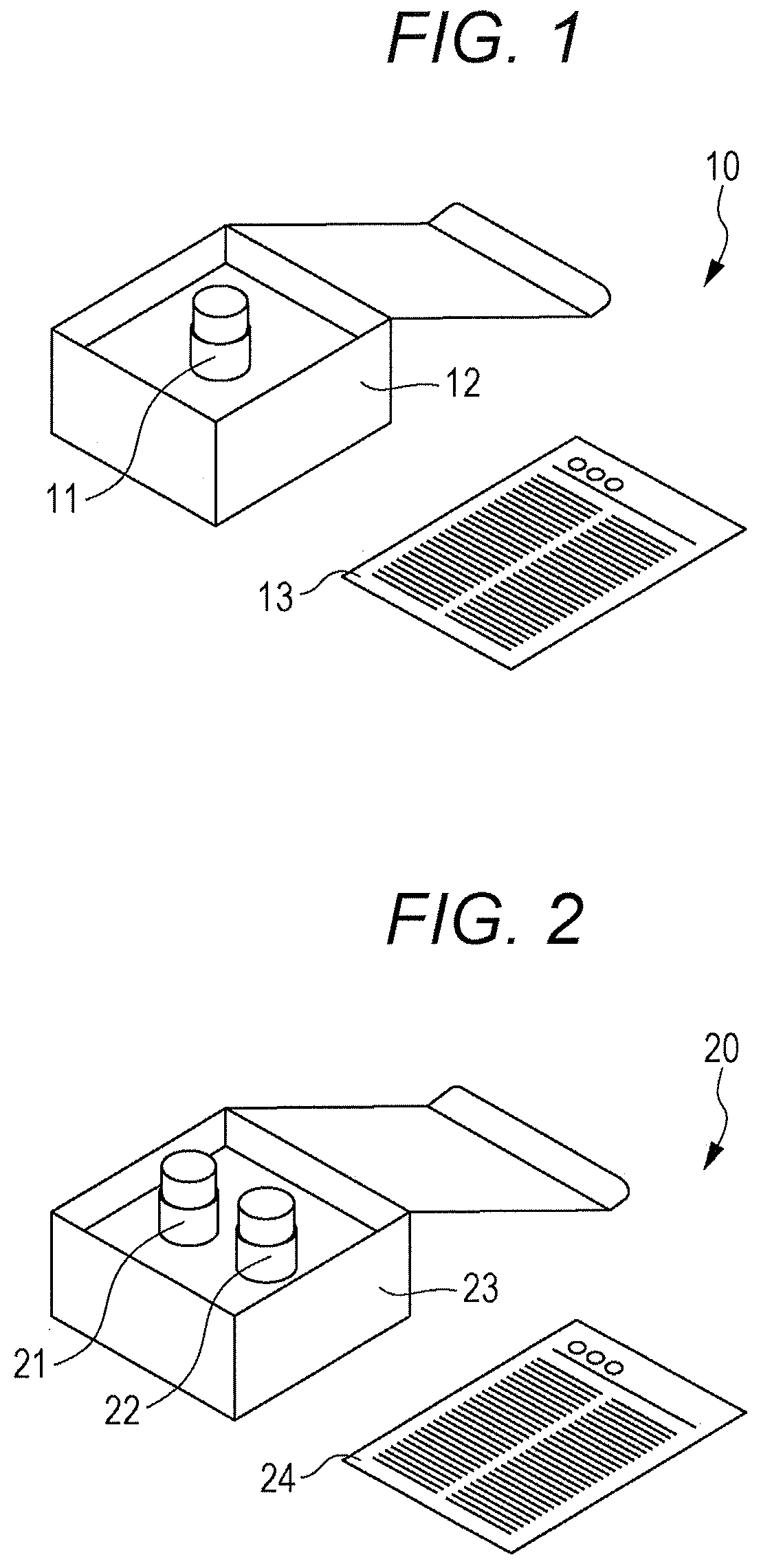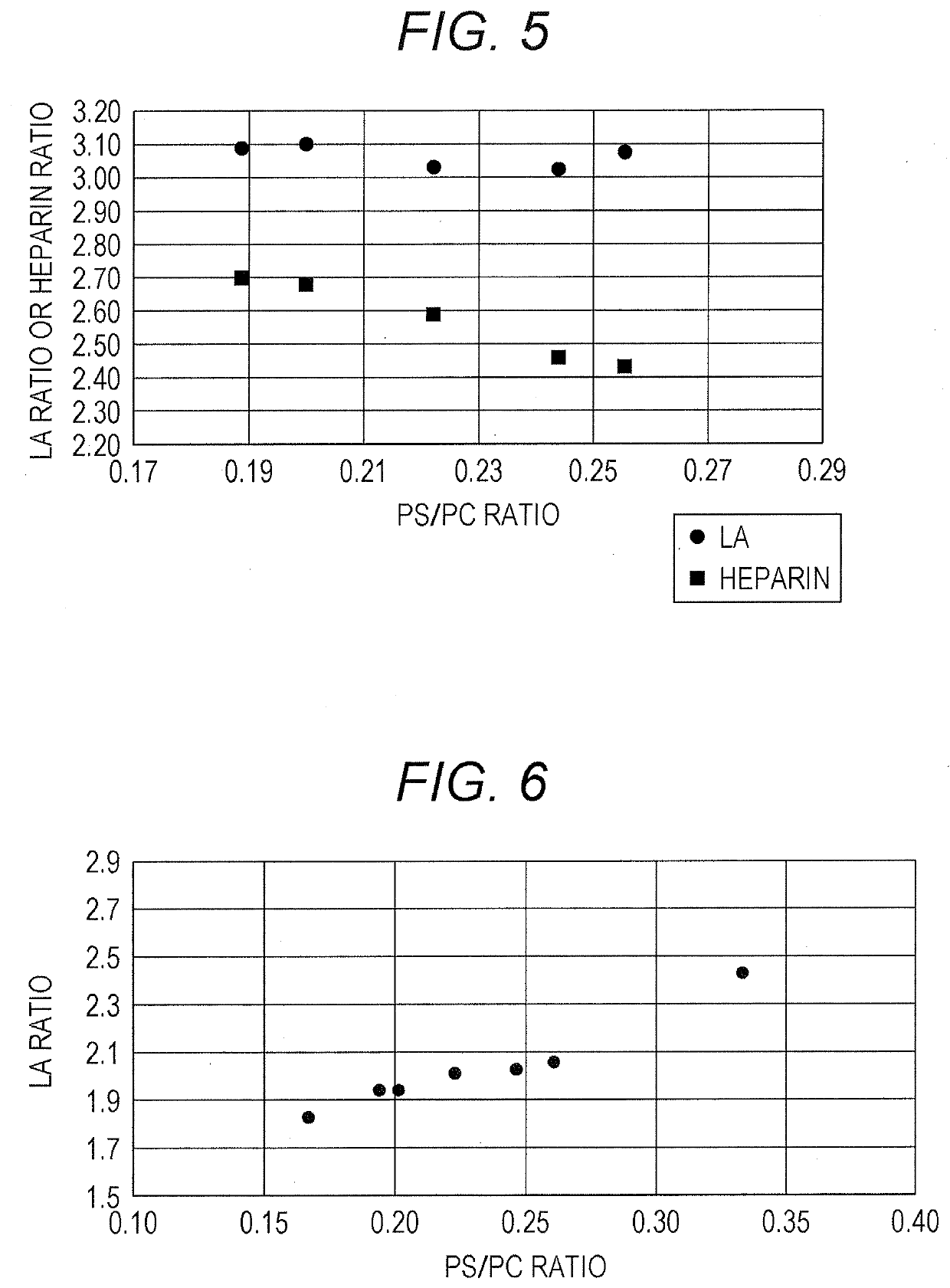Reagent for determination of coagulation time, production method therefor, reagent kit, and method for determination of coagulation time
a technology of coagulation time and reagent, which is applied in the field of reagent production method therefor, reagent kit, and method for determining coagulation time, can solve the problems of long coagulation time and the inability of aptt reagents specialized for the detection of la to be suitable for screening tests for intrinsic coagulation factors, so as to improve the sensitivity to la and the effect of easy inhibition of the reaction
- Summary
- Abstract
- Description
- Claims
- Application Information
AI Technical Summary
Benefits of technology
Problems solved by technology
Method used
Image
Examples
example 1
[0075]Effects on the sensitivity to LA and to heparin were investigated for APTT reagents with varied concentrations of one of three phospholipids (a PE, a PC and, a PS) contained therein.
(1) Reagents
[0076](1.1) Preparation of liposomes
[0077]A solution of the phospholipids in chloroform, containing a given amount of each of dioleoyl (DO) PE (Avanti Polar Lipids, Inc.), DOPC (Avanti Polar Lipids, Inc.), and DOPS (Avanti Polar Lipids, Inc.), was prepared and placed into an eggplant flask. The eggplant flask was rotated on a rotary evaporator to evaporate the chloroform, thereby forming a thin film of the phospholipid on the inner wall of the flask. To the flask was added 1000 mL of buffer (containing TAPS, HEPES, and glycine, pH 7.4) was added to swell the phospholipid thin film, thereby obtaining a buffer containing liposomes. The liposome-containing buffer was stirred by a stirrer at 500 rpm for 60 minutes. Then, the liposome-containing buffer was subjected to sonication at 37 kHz f...
example 2
[0085]Effects on the sensitivity to LA and to heparin were further investigated for APTT reagents with a fixed PS concentration and varied PC concentrations. For comparison, commercially available APTT reagents were also used.
(1) Reagents
(1.1) First and Second Reagents
[0086]The phospholipids employed DOPE, DOPC, and DOPS. APTT reagents with varied PC concentrations were prepared as in Example 1. For the APTT reagents in Example 2, the standard concentrations of the PE, the PC, and the PS were 15 μg / mL, 45 μg / mL, and 10 μg / mL, respectively. The composition of the phospholipids in the respective APTT reagents was as shown in Table 7. The second reagent in Example 1 was used as an aqueous solution containing calcium ions.
TABLE 7Phospholipid varied in concentrationPCDeviation from standard concentration (%)−33.3−15−100101533.3PE (μg / mL)15151515151515PC (μg / mL)3038.2540.54549.551.7560PS (μg / mL)10101010101010Total phospholipid5563.2565.57074.576.7585(μg / L)PS / PC0.330.260.250.220.20.190.17
(...
example 3
[0093]Effects on the sensitivity to LA and to heparin were investigated for APTT reagents with a fixed concentration ratio PS / PC and varied concentrations of each of the phospholipids.
(1) Reagents and Blood Samples
[0094]The phospholipids employed DOPE, DOPC, and DOPS. APTT reagents in which the concentrations of the respective phospholipids were varied with a fixed PS / PC ratio of 0.22 were prepared as in Example 1. The composition of the phospholipids in the respective APTT reagents was as shown in Table 9. The second reagent in Example 1 was used as an aqueous solution containing calcium ions. The normal sample, the LA-containing sample, and the heparin-containing sample were the same as in Example 2.
TABLE 9PE (μg / mL)242118151296PC (μg / mL)72635445362718PS (μg / mL)16141210864Total phospholipid112988470564228(μg / mL)PS / PC ratio0.220.220.220.220.220.220.22
(2) Determination of Coagulation Time
[0095]The coagulation times of the respective blood samples were determined using the first and ...
PUM
 Login to View More
Login to View More Abstract
Description
Claims
Application Information
 Login to View More
Login to View More - R&D
- Intellectual Property
- Life Sciences
- Materials
- Tech Scout
- Unparalleled Data Quality
- Higher Quality Content
- 60% Fewer Hallucinations
Browse by: Latest US Patents, China's latest patents, Technical Efficacy Thesaurus, Application Domain, Technology Topic, Popular Technical Reports.
© 2025 PatSnap. All rights reserved.Legal|Privacy policy|Modern Slavery Act Transparency Statement|Sitemap|About US| Contact US: help@patsnap.com



